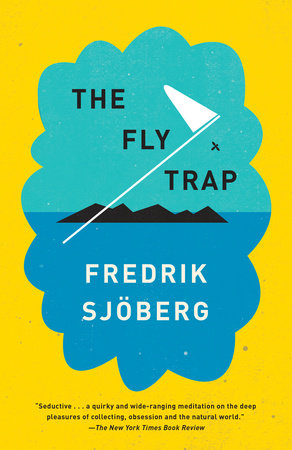Fredrik Sjöberg - The Fly Trap
Fredrik Sjöberg 2006. The Fly Trap. New York: Pantheon Books. 278 pp. Translated from the Swedish by Thomas Teal.
At first this seems merely a harmless ramble on the subjects of collecting, hoverflies, life on a small Swedish island and René Malaise (inventor of the Malaise trap for catching insects, famous only among entomologists). (René Malaise, 1892–1978, was a previous inhabitant of the island of Runmarö, where the author Sjöberg now lives.) A modest amount of autobiographical content is also dispersed through the narrative. The “collecting” content and commentary is inconsequential due to the arbitrary and narrow interest of the author who declares early on that he is only interested in the hoverfly family and only in those species that can be found on his own island. It would, however, have been a big mistake to abandon reading this book (as I nearly did).
Apparently this little book is has the status of a minor cult book in the author’s native Sweden. I was not at first similarly impressed, but it grew and grew. Partly because Sjöberg’s knowledge of hoverflies and other insects is much greater than he initially makes out, but also because of the depth of his historical research into the life of René Malaise who was an adventurous traveller. He spent nearly the entire 1920s decade in Kamchatka and Japan in very difficult conditions then followed up with a trip to remote parts of Burma (although with a new wife). Another adventure was planned to Ceylon, India and the Himalaya but abandoned due to the Second World War. As Sjöberg points out, such adventurers have long since been replaced by filmmakers, although Malaise and his like had an equivalent role and great public recognition in their day.
On another level, the author gradually leads the reader to believe that this is just a book about slowing down, about gaining pleasure from making, without haste, observations of the natural world. Whatever. Hardly a novel or controversial view to advocate.
Then, when I was almost ready for a second time to abandon the book, yet again an unexpected reward for persistence: in Chapter 14 it is revealed that René Malaise rejected the theory of plate tectonics, which was only recently becoming widely accepted. Although he also held some loopy ideas about Atlantis and other things, Malaise wasn’t totally wrong about everything (who is?). Some quotes:
Malaise in Sjöberg’s words (p. 205):
“Wegener’s theory was humbug. The earth’s crust, he insisted, was far too thick. No force on earth could be strong enough to propel such a sideways migration. Never. He found particularly ridiculous the piece of the theory that said the Indian subcontinent had come whizzing along from the south with such force that the collision with the rest of Asia had pushed up the Himalayas and the Tibetan plateau. Not a chance.”
Malaise in his own words (p. 213):
“Scientists of to-day, be it geologists, geophysicists, or oceanographers, are so overspecialized that they master only a limited sector of their own branch. Outside this sector they hardly dare to express an opinion. The fundamental theories on which, for instance, geology is based have mostly been in use for generations and have in their mind ceased to be theories and have attained almost the standing of axioms.”
Sjöberg again (p. 216):
“When everything is said and done, the days of really revolutionary breakthroughs are perhaps not over. Maybe, sooner or later, someone will sweep Wegener right out of the door.”
Indeed.
Much more to come on that, elsewhere. For the moment, and in the spirit of even-handedness, one advocate of the most plausible alternative to plate tectonics is here and the web abounds with many shrill responses from plate tectonics advocates.



